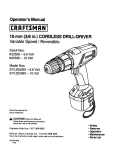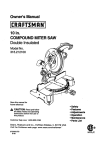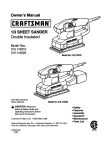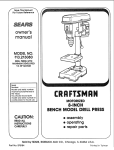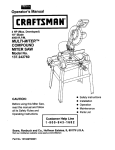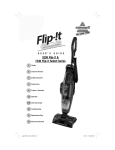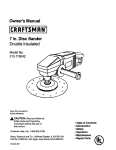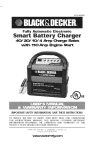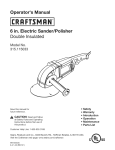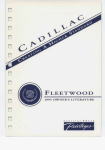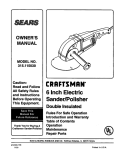Download Craftsman 315.115032 Operator`s manual
Transcript
Operator's Manual tI:RRFTSMRN'I 6 in. Electric SanderlPolisher Double Insulated Model No. 315.115032 • Safety • Warranty • I ntroduction Save this manual for future reference. CAUTION: Read and follow all Safety Rules and Operating Instructions before first use of this product. • Operation • Maintenance • Parts List Customer Help Line: 1-800-932-3188 Sears, Roebuck and Co., 3333 Beverly Rd., Hoffman Visit the Craftsman web page: www.sears.com/craftsman 972000-990 9-02 Estates, IL 60179 USA Illl C_ I US • Table of Contents / Warranty / Introduction ....................................................................................................... • General Safety Rules ..................................................................................................................................... • Specific Safety Rules ......................................................................................................................................... 4 • Symbols ............................................................................................................................................................. 5 • Product Specifications • Operation ...................................................................................................................................................... • Maintenance .................................................................................................................................................... • Accessories ..................................................................................................................................................... • Exploded View and Repair Parts List ......................................................................................................... • Parts Ordedng/Service 2 3-4 ....................................................................................................................................... 6 6-10 11 11 12-13 ................................................................................................................................... FULL ONE YEAR WARRANTY ON CRAFTSMAN 14 SANDER/POLISHER If this rRRFT$14RN Sander/Polisher fails to give complete satisfaction within one year from the date of purchase, RETURN IT TO THE NEAREST SEARS STORE OR SEARS SERVICE CENTER IN THE UNITED STATES, and Sears will replace it, free of charge. If this ERRFTSNRN Sander/Polisher days from the date of purchase. is used for commercial or rental purposes, this warranty applies for only 90 This warranty gives you specific legal rights, and you may also have other rights which vary from state to state. Sears, Roebuck and Co., Dept. 817WA, Hoffman Estates, Congratulations and thank you for buying this Craftsman 6 inch Electric SandedPolisher. Your tool A has been designed, engineered and manufactured to provide you with Sears high standard of dependability, ease of operation, and operator safety+ Propedy cared for it will give you years of rugged, trouble-free performance. IL 60179 CAUTION: Carefully read through this entire operator'smanual before using your new sanded polisher.Pay close attentionto the Rules for Safe Operation, Warnings and Cautions, If you use this tool prepedy and onlyfor what it is intended, you willenjoy years of safe, reliable service. Your sander!polisherhas many features for making your sanding/polishingoperationsmore pleasant and enjoyable. Safety, performance and dependability have been given top pdodty in the design of this tool making it easy to maintain and operate. Look this symbol Your to point important means forattentionllt safety out is involved. ,_k safety precautions. It WARNING: The operation of any sander/polishercan result in foreign objects being thrown intoyour eyes. which can result in severe eye damage. Before beginning pewer tool operation, always wear safety goggles or safety glasses with side shieldsand a fullface shieldwhen needed, We recommend Wide Vision Safety Mask for use over eyeglasses or standard safety glasses with side shields, available at Sears Retail Stores. Always wear eye protection which is marked to complywith ANSI Z87,1. 2 WARNING: Read and understand all instructions, Failure to follow all instructionslisted below may result in eiectdc shock,fire and/or sedous personal injury. SAVE THESE INSTRUCTIONS • Dress propedy. Do not wear loose clothing or jeweky. Contain long hair, Keep your hair, clothing, and gloves away from moving parts. Loose clothes, jewelry, or long hair can be caught in moving parts. • Avoid before on the switch • Remove adjusting keys or wrenches before tuming the tool on, Awrench or a key that is left attached to a rotating part of the tool may result in personal injury. Do not overreach, Keep proper footing and balance at all times, Proper footing and balance enables better control of the tool in unexpected situations. Work Area • Keep your work area clean and well lit. Cluttered benches and dark areas invite accidents. • Do not operate power tools in explosive etmospherss, such as in the presence of flammable liquids, gases, or dust. Power tools may create sparks which may ignite the dust or fumes. Keep bystanders, children, and visitors away while operating a power tool. Distractions can cause you to lose control. • • Electrical Safety • Double insulated tools are equipped with a polarized plug (one blade is wider than the other). This plug will fit in a polarized outlet only one way, If the plug does not fit fully in the outlet, reverse the plug. If it still does not fit, contact e qualified electrician to install e polarized outlet. Do not change the plug in any way, • • • • Use safety equipment. Always wear eye protection, Dust mask, non-skid safety shoes, hard hat, or hearing protection must be used for appropriate conditions. Tool Use and Care • Double insulation [] eliminates the need for the three-wire grounded power cord and grounded power supply system. • Avoid body contact with grounded surfaces, such as pipes, radiators, ranges, and refrigera. tore. There is an increased dsk of electric shock if your body is grounded. • Don't expose power tools to rain orwet conditions, Water entedng a power tool will increase the dsk of electric shock. Do not abuse the cord, Never use the cord to • carry the tools or pull the plug from an outlet, Keep cord away from heat, oil, sharp edges, or moving parts, Replace damaged cords immediately. Damaged cords increase the risk of electric shock. • • • • When operating a power tool outside, use an outdoor extension cord marked "W-A" or "W'. These cords are rated for outdoor use and reduce the risk of electric shock, Personal accidental starting. Be sure switch is off plugging in, CarTying tools with your finger switch or plugging in tools that have the on invites accidents. Safety Stay alert, watch what you are doing and use common sense when operating a power tool. Do not use tool while tired or under the influence of drugs, alcohol, or medication. A moment of inattention while operating power tools may result in serious personal injury, 3 Use clamps or other practical way to secure and support the workpiece to a stable platform. Holding the work by hand or against your body is unstable and may lead to loss of control. Do not force tool. Use the correct tool foryour application. The correct tool will do the job better and safer at the rate for which it is designed. Do not use tool if switch does not turn it on or off. Any tool that cannot be controlled with the switch is dangerous and must be repaired. Disconnect the plug from power soume before making any adjustments, changing accessodee, or storing the tool. Such preventive safety measures reduce the risk of starting the tool accidentally, Store idle tools out of the reach of children and other untrained persons, Tools are dangerous in the hands of untrained users. Maintain tools with care. Keep cutting tools sharp and clean. Properly maintained tools with sharp cutting edges are less likely to bind and are easier to control. • Check for miselignment or binding of moving parts, breakage of parts, and any other condition that may affect the tool's operation, If damaged, have the tool sewiced before using. Many accidents are caused by poody maintained tools. • Use only accessories that are recommended the manufacturer for your model. Accessories that may he suitable for one tool, may become hazardous when used on another tool, by Service • • Tool service must be performed only by qualified repair personnel, Service or maintenance performed by unqualifiedpersonnel could result in a risk of injury. • • Hold tool by insulated gripping surfaces when performing an operation where the tool may contact hidden wiring or its cord. Contact with a "live" wire will make exposed metal parts of the tool "live" and shock the operator. Accessories must be rated for at least the speed recommended on the tool warning label. Wheels and other accessories running over rated speed can fly apart and cause injury. Additional • • • • • • • When servicing a tool, use only identical re. placement parts, Follow instructions in the Maintenance section of this manual. Use of unauthorized parts or failure to follow Maintenance Instructions may create a risk of electric shock or injury. Rules For Safe Operation Know your power tool. Reed operator's manual carefully. Learn its applications and limitations, as well as the specific potential hazards related to this tool. Following this rule will reduce the risk of electric shock, fire, or serious injury. Always wear safety glasses. Everyday eyeglasses have only impact-resistant lenses; they are NOT safety glasses. Following this rule will reduce the risk of serious personal injury. Protect your lungs. Wear a face or dust mask if the operation is dusty. Following this rule will reduce the risk of sedous personal injury. Protect your hearing. Wear hearing protection during extended periods of operation. Following this rule will reduce the risk of serious personal injury. Inspect tool cords periodically and, if damaged, have repaired at your nearest authorized service center. Constantly stay aware of cord location. Following this rule will reduce the risk of electdc shock or fire. Check damaged parts. Before further use of the tool, a guard or other part that is damaged should be carefully checked to determine that it will operate propedy and perform its intended function. Check for alignment of moving parts, binding of moving pads, breakage of parts, mounting, and any other conditions that may affect its operation. A guard or other part that is damaged should be propedy repaired or replaced by an authorized service center, Following this rule will reduce the risk of shock, fire, or serious injury. Do not abuse cord. Never carry the tool by the cord or yank it to disconnect it from the receptacle. Keep cord away from heat, oil, and sharp edges. Following this rule will reduce the dsk of electdc shock or fire, • • • • Make sure your extension cord is in good condition. When using an extension cord, be sure to use one heavy enough to cemj the current your product will draw. A wire gage size (A.W.G.) of at least 16 is recommended for an extension cord 100 feet or less in length. A cord exceeding t00 feat is not recommended. If in doubt, use the next heavier gage. The smaller the gage number, the heavier the cord. An undersized cord will cause a drop in line voltage resulting in loss of power and overheating. Inspect forand remove all nails from lumber before sanding. Following this rule will reduce the risk of serious personal injury. Drugs, alcohol, medication. Do not operate tool while under the influence of drugs, alcohol, or any medication, Following this rule will reduce the risk of electric shock, fire, or serious personal injury, Save these instructions, Refer to them frequently and use them to instruct others who may use this tool. If you loan someone this tool, loan them these instructions also, _IWARNING: Some dust created by power sanding, sawing, grinding, drilling, and other construction activities contains chemicals known to cause cancer, birth defects or other reproductive harm, Some examples of these chemicals are: • lead from lead-based paints, • crystalline silica from bricks and cement and other masonry products, and • arsenic and chromium from chemicallytreated lumber. Your risk from these exposures varies, depending on how often you do this type of work. To reduce your exposure to these chemicals: work in a well ventilated area, and work with approved safety equipment, such as those dust masks that are specially designed to filter out microscopic particles. SYM BOL NAM E DESIGNATION/EXPLANATION V Volts Voltage A Amperes Current Hz Hertz Frequency (cycles per second) min Minutes Time Alternating Current Type or a characteristic of current W Watts Power no No Load Speed Rotational speed, at no load ] Class II Construction Designates Double insulated Construction Tools .,./rain Revolutions or Reciprocation Per Minute Revolutions, strokes, surface speed, orbits etc. per minute A Indicates danger, warning or caution. It means attentionH! Your safety is involved. Safety Alert Symbol The purpose of safety symbols is to attract your attention to possible dangers. The safety symbols, and the explanations with them, deserve your careful attention and understanding. The safety warnings do not by themselves eliminate any danger. The Instructions or warnings they give are not substitutes for proper accident prevention measures. SYMBOL MEANING SAFETY ALERT SYMBOL: Indicates danger, warning, or caution. May be used in conjunctionwith other symbols or pictogrephs, DANGER: Failureto obey a safety warningwill resultin serious injuryto yourself otto others. Always followthe safety precautionsto reducathe riskoffire, electricshock,and personal injury. WARNING: Failure to obey a safety warning can result in serious injury to yourself or to others, Always follow the safety precautions to reduce the risk of fire, electric shock, and personal injury. CAUTION: Failure to obey a safety warningmay resultin propertydamage or personal injury to yourselforto others,Always followthe safety precautionstoreduce the dskoffire, electricshock, and personal injury. NOTE: Advises you of information or instructions vital to the operation or maintenance SAVE THESE INSTRUCTIONS 5 oft he equipment, Size of Sanding Disc Size of Polishing Sonnet Horsepower 6 inches 6 inches Rating Spindle Size 1/2 No Load Speed 1,400/min. & 1650/min. TWO SPEED SWITCH See Figure 1. WARNING: Always wear safety goggles or safety glasses with side shields when operating your sandedpolisher. Failure to do so could result in dust, shavings, loose particles or foreign objects being thrown into your eyes, causing possible serious injury. Your sander/polisheris equipped with a two speed switchtdgger locatedin the rear handle, To turn ON, depress switchtdgger, to turn OFF, release switch tdgger, For low speed sandingor polishing, depress switchtdgger haffway. For high speed sandingor polishingdepress switchtrigger all the way. Be sum switch trigger is in OFF position before connecting to power supply source. KNOW YOUR SANDER/POLISHER Your sandedpolisher is suitable for sandingwith coarse, medium, and fine grit sanding discs. When used with the polishing bonnet supplied, it can also be used as a bufferor polisher. WARNING: Do not allow familiaritywith your tool to make you careless. Remember that a careless fraction of a second is sufficientto inflict severe injury. Before attempting to use any tool, familiarize yourself with all operating features and safety requirements. ,_ 120 volts, 60 Hz, AC only, 4.5 amps. 1/2 inch 20 TPI WARNING: The double insulated system is intended to protect the usar from shock resulting from a break in the tool's internal wiring. Observe all normal safety precautions related to avoiding electrical shock, POUSHING BONNET SWITCHTRIGGER SANDINGDISC (NOTINCLUDED) AUXlUARYHANDLE Fig. 1 6 _i WARNING: Your sander/polishershould never be connected to power supplywhen you are assembling parts, making adjustments, assembling or replacing sanding discs or bonnets, cleaning, or when not in use, Disconnecting sander/polisher will prevent accidental starting that could cause serious personal injury. LOCK-ON BUTTON See Figure 2. Your sander/polisher is equipped with a "lock-on" feature, which is convenient when continuous operation for extended periods of time is rrequired. This feature can be used for both high and low speeds. To lock or=, depress the switch tdgger, push in and hold the "lock-on" button located on the side of the handle, then release the switch tdgger, Release "lockon" button and your sander/polisher will continue running. To release the Iock,.on feature, depress switch trigger and release it. AUXILIARY HAN DLE See Figure 2. RUBBER_$C CLOCKWISE An auxiliary handle is pocked with your sander/polisher for ease of operation and to help prevent loss of control.Any loss of control could result in an accident, causing possible serious personal injury. The motor housingsare designed so that the aL_iliary handle can be installed on either side of the unit, TO INSTALL: • Fit bolt through hole in motor housing and thread into hex nut provided internally. Tighten bolt and handle securely. • INSTALLING OR REMOVING See Figure 3, • RUBBER DISC Unplug your sander/polisher. ,_ • • • WARN IN G: Failure to unplug your sander/ polisher could result in accidental starting causing possible sedous personal injury. Position the tool as shown in figure 3 and align the spindle lock hole with the two half-circle notches in motor housing, Lock spindle by inserting the pin provided through spindle lock hole and trapping it in half circle notches, This will prevent spindle from rotating, Thread rubber disc, flat face up, onto spindle in a clockwise direction. Turn until rubber disc shoulders on the spindle. The unit is now ready for installation of the sanding disc or polishing bonnet. ELECTRICAL CONNECTION Your sandedpelisher has a precision built electric motor. It should be connected to a power supply that is 120 volts. 60 Hz_AC only (normal household current), Do not operate this tool on direct current (DC). A substantial voltage drop will cause a loss of power and the motor will overheat. If your tool does not operate when plugged into an outlet, double-check the power supply, 7 SANDING DISC SELECTION Selecting the correct size grit and type sanding disc is an extremely important step in achieving a high quality sanded finish. Aluminum oxide, silicon carbide, and other synthetic abrasives are best for power sanding. Natural abrasives, such as flint and garnet are too soft for economical use in power sanding. SPANNERWRENCH SPANNERNUI" In general, coarse grit will remove the most material and finer grit will produce the best finish in all sanding operations. The condition of the surface to be sanded will determine which grit will do the job. If the surface is rough, start with a coarse grit and sand until the surface is uniform, Medium grit may then be used to remove scratches lef_ by the coarser grit and finer gdt used for finishing of the surface. _ SANDING DISC iLI (NOTINCLUDED) Always use the proper grit sanding disc, and not extra pressure when sanding. Continue sanding with each grit until surface is uniform. INSTALLING OPTIONAL See Figure 4. • SANDING DISC Unplug your sanderlpolisher. _1= WARN IN G: Failureto unplug your sander/polisher could result in accidental startingcausing possible serious personal injury. • • • _ Position the tool as shown in figure 4 and align the spindle lock hole with the two half-circle notches in motor housing. Lock spindle by inserting the pin provided through spindle lock hole and trapping it in half circle notches. This will prevent spindle from rotating. Center the sanding disc over the rubber disc and start spanner nut onto threaded spindle in a clockwise direction. Securely tighten spanner nut with the spanner wrench provided. WARNING: Remove pin before attemptingto operate sander/polisher. Failure to do so could cause pin to be thrown from the tool resulting in possibleserious injury. Fig. 4 APPLICATIONS (Use only for the purposes listed below) • Sanding on wood surfaces. • Removing rust from and sanding steel surfaces. • Polishing and buffing. ,_ WARNING: Before connectingyour sander/ polisherto power supply source, always check to be sure switch is not in "lock-on" position. Failure to do so could result in accidental startingof your sander/polisherresulting in possibleserious injury. PREPARING FOROPERATION For ease of operation, this tool has a front aL_iliary handle and mar handle. See Ffgure 1. This provides for two-hand operation, which is necessary in order to maintain proper control and keep both hands clear of the sanding disc and sanding area, When operating your sander/polisher, always use both hands. Check the auxiliary handle before each use and make sure the handle bolt is tight against the housing. SANDING Clamp or otherwise secure the work to prevent it from moving under your sander/polisher, Secure small workpieces in a vise or use clamps to secure them to a workbench. _, WARNING: Unsecured work could be thrown towards the operator causing injury. Hold the tool in front and away from you, keeping it clear of the workpiece. Start the tool by depressing the switch trigger and letting the motor build to its maximum speed. Gradually lower sander/polisher to the workpiece at a slight 5° to 8° angle. See Figure 5. DO NOT A'n'EMPT TO HOLD THE SANDING DISC FLAT ON THE WORKPIECE. Always keep the tool in motion moving over the work, allowing it to operate freely without unnecessary pressure. The weight of the unit supplies adequate pressure, so let the sanding disc and sander do the work. Applying additional pressure only slows the motor, rapidly wears sanding discs and greatly reduces sander speed. Excessive pressure will ovedoad the motor causing possible damage from motor overheating and can result in inferior work. Any finish or resin on wood may soften from the frictional heat. Do not allow sanding on one spot too long. Sanding in one spot too long will cause uneven sanding and gouging of the work. _.WARNING: Keep a firm grip on the tool with both hands at all times. Failure to do so could result in loss of controlleading to possible sedous injury. Upon completion of a sanding operation, lift tool away from work surface before turning off. _I, WARNING: Sanding disc must come to a complete stop before setting tool down on workbench. Failure to do so can cause the tool to be thrown from workbench because of sanding disc ro_ation, This could result in damage to the tool or possible sedous injury to the operator. _1=WARNING:Donotwear loose clothing or jewelry when operating this tool, They could get caught in moving parts causing sehous injury. Keep head away from sender/polisher and sanding or polishing area. Hair could be drawn into sender/polisher causing serious injury, INSTALLING POLISHING BONNETS See Figure 6. • Unplug your sander/polisher, _IL WARNING: Failure to unplug your sender/ polisher could result in accidental starting causing possiblesedous personal injury. • if you have been using this tool as a sender, remove spanner nut and sanding disc, Slip polishing bonnet over rubber disc, pull string ends tight, and tie in a bow to secure bonnet. • • Tuck stnng ends and bow underneath _. TUCKSTF_NGENDSAND BOWUNDERNEATH BONNET Fig. 6 bonnet. WARNING: Failure to tuck string ends and bow underneath bonnet could result in string ends coming loose and hitting or grabbing foreign objects, POLISHING See Figure FOR BEST RESULTS, ALWAYS SPEED WHEN POLISHING. OPERATE AT LOW Hold the tool firmly, allowing it to operate freely without unnecessary pressure. This tool was designed so that the weight of the tool alone will provide adequate pressurefor polishing at top efficiency. BONNETS MUST BE KEPT CLEAN AND FREE FROM GRIT, DIRT, AND OTHER ABRASIVE PARTICLES. When bonnets become dirty and clogged with polishing film, wash in lukewarm water with a mild detergent. Allow bonnets to dry throughly before reuse. Polish with a long sweeping motion, back and forth, advancing along the surface to be polished. Do not hold the tool in one spot or use a circular or spiral pattern. This will cause swids in the finish. Spread a light coat of polish or wax over a small area. Polish with the tool according to the manufacturer's instructions printed on the label of the polish or wax container. Fig. 7 power cord over sections already polished, particularly on automobiles. Surfaces that have an old film of wax or polish, or that have not been polished or waxed for an extended period of time, may require a second application. This is especially true on oxidized surfaces. Heavily oxidized surfaces should be cleaned with a commercial paste or liquid cleaner before polishing or waxing. Note; Some polishes should be buffed while damp where others must be allowed to dry; therefore always check the manufacturer's label. _k Tilt the tool so that the polishing bonnet is at a slight angle to the work surface, Always start polishing at the top or highest point and work down. This will prevent light dust or polish film from being thrown upon completed section, It also eliminates pulling the tool's 10 WARNING: Check polishing bonnets before each use. Make sure they are clean and free from any loose particlesor foreign objectsthat may be embedded in the bonnet. Failure to do so could cause these particlesor objectsto be thrown from the tool resulting in possible serious injury, DOUBLE INSULATION is a safety concept in electric power tools, which eliminates the need for the usual three wire grounded power cord and grounded supply system. Wherever there is electric current in the tool there are two complete sets of insulation to protect the user. All exposed metal parts are isolated from internal metal motor components with protecting insulation IMPORTANT -- Servicing of a tool with double insulation requires extreme care and knowledge of the system and should be performed only by a qualified service tecnhician. For service we suggest you re(urn the tool to your nearest Sears Store for repair. Always use original factory replacement parts when servicing, A WARNING: When servicing use only identical Craftsman replacement parts, Use of any other parts may create a hazard or cause product damage. Consequently it is not recommended that this tool be used for extended work on any fiberglass material, wallboard, spackling compounds, or plaster, During any use on these materials, it is extremely important that the tool is cleaned frequently by blowing with an air jet. ,_ EXTENSION CORDS The use of any extension cordwill cause some loss of power. To keep the loss to a minimum and to prevent tool overheating,use an extensioncord that is heavy enoughto cany the current the tool will drew. Awire gauge size (A.W.G.) of at least 16 is recommendedfor an extension cord 100 feet or less in length. When workingoutdoors,use an extensioncord that is suitablefor outdooruse. The cord'sjacketwill be marked WA. GENERAL Only the parts shown on parts list, page 13, are intended to be repaired or replaced by the customer. All other parts represent an Jmpprtant part of the double insulation system and should be serviced only by a qualified Sears service technician. Avoid using solvents when cleaning plastic parts. Most plastics are susceptible to vadous types of commercial solvents and may be damaged by their use. Use clean cloths to remove dirt, carbon dust, etc. WARNING: Do not at any time let brake fluids, ,_k gaseline, petroleum-based products,penetrating oils, etc, come in contact with plastic parts, They contain chemicals that can damage, weaken, or destroy plastic. RECOMMENDED Polishing ACCESSORIES A CAUTION: Keep extension cords away from the sandingarea and position the cord so that it will not get caughton lumber, tools, etc., during sandingor polishingoperation, _k WARNING: Check extension cords before each use. If damaged replace immediately. Never use tool with a damaged cord since touchingthe damaged area could cause electrical shock resulting in serious injury, LUBRICATION All of the bearingsin this tool are lubricated with a sufficient amount of high grade lubricant for the life of the unit under normal operatingconditions, Therefore, no further lubdsetionis required. When electric tools are used on fiberglass boats, sports cars, wallboard, spackling compounds, or plaster, it has been found that they are subject to accelerated wear and possible premature failure, as the fiberglass chips and grindings are highly abrasive to bearings, brushes, commutators, etc. THE FOLLOWING WARNING; Always wear safety goggles, or safety glasses with side shields during power tool operation or when blowing dust. If operation is dusty, also weara dust mask. ARE CURRENTLY AVAILABLE AT SEARS RETAIL STORES Bonnet Assorted Sanding Discs 150 Gdt -- Fine 100 Grit -- Medium 60 Gdt -- Coarse 40 Grit -- Very Coarse A WARNING: The use of attachments or accessories not listed above might be hazardous. 11 CRAFTSMAN SANDER/POLISHER - MODEL NUMBER 3t5.115032 SEE NOTE "A", Page 13 6 4 12 CRAFTSMAN SANDER/POLISHER - MODEL NUMBER 315.115032 _-- I The model number will ba found on a plate attached to the motor housing. Always mention the model 1 number in all correspondence regarding your CRAFTSMAN SANDER/POLISHER or when ordering repair parts. I SEE BACK PAGE FOR PARTS ORDERING INSTRUCTIONS PARTS LIST Key No. Part Number Description 1 974892-001 Polishing 2 612186-003 Spanner Nut ............................................... 3 Sanding Quan. Bonnet ........................................ 1 1 Disc 4 622322-001 Rubber Disc ............................................... 1 5 983001-001 Data Plate .................................................. 1 6 976491-001 Logo Plate .................................................. 1 7 972895-005 Auxiliary Handle ......................................... 1 8 621984-00O Spanner Wrench 1 9 621230-000 Pin .............................................................. 972000-990 Operator's ........................................ 1 Manual NOTE: "A" -- The assembly shown represents an important part of the Double Insulated System. To avoid the possibility of alteration or damage to the System, service should be performed by your nearest Sears Repair Center. Contact your nearest Sears Catalog Order or Retail Store for service center information. *** Sanding discs in assorted grits for sanding nearest Sears Retail Store. both wood and metal may be obtained 13 from your Your Home For repair-in your home-of all major brand appliances, lawn and garden equipment, or heating and cooling systems, no matter who made it, no matter who sold it! For the replacement parts, accessories and owner's manuals that you need to do-it-yourself. For Sears professional installation of home appliances and items like garage door openers and water heaters. 1-800-4-MY-HOME ® (1-800-469-4663) Call anytime, day or night(U.S.A, www.sears.com and Canada) www.sears.ca Our Home For repair of carry-in items like vacuums, lawn equipment, and electronics, call or go on-line for the location of your nearest Sears Parts & Repair Center. 1-800-488-1222 Call anytime, day or night (U.S.A. only) www.sears.com To purchase a protection agreement on a product serviced by Sears: 1-800-827-6655 (U.S.A.) Para pedir servicio de reparacibn a domicilio, y para ordenar piezaa: 1-888-SU-HOGAR _ (1-888-784-6427) 1-800-361-6665 Au Canada (Canada) pour service en fran_ais: 1-800-LE-FOYER "c (1-800-533-6937) www.sears.ca SWARS ® Registered Trademark / _ Trademark / sa Service Mark of Sears, Roebuck a_d Co. ® Marca Registrada / TMMarca de F,_rica / s_ Marca de Setvlclo de Sears, Roebuck and Co. MCMarque de commerce / tad Marque d_p os/ae de Sears, Roebuck and Co. ® Sears, Roebuck and Co.














